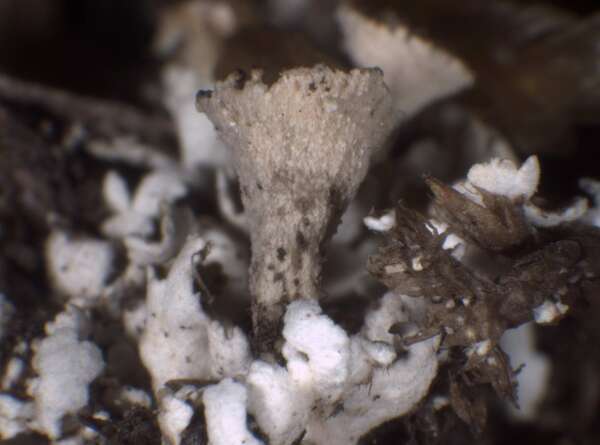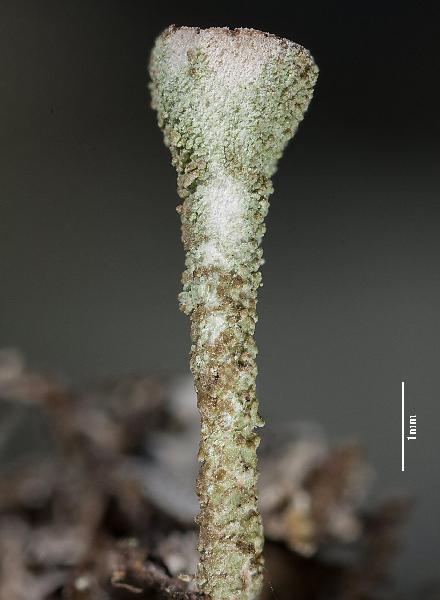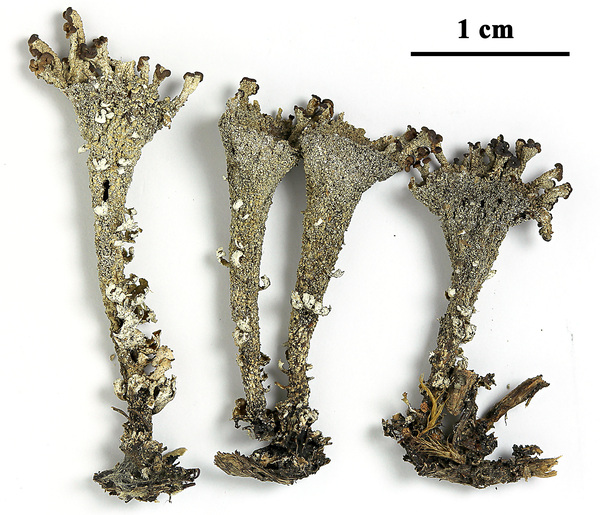Cladonia grayi Sandst.
G. Merr. ex Sandst., Clad. Exs.: nr. 1847, 1929.
Synonyms: Cladonia pyxidata subsp. grayi (Sandst.) V. Wirth
Distribution: N - Frl, Ven, TAA (Nascimbene & al. 2007b), Lomb (Ravera & al. 2019a, Gheza 2019), Piem (Isocrono & al. 2004, Isocrono & Piervittori 2008), VA (Piervittori & Isocrono 1999, Matteucci & al. 2008c). C - Tosc.
Description: Primary thallus squamulose, usually persistent, forming a small crust, the squamules ascendent, small to middle-sized, 1-2(-3) mm, crenulate, white beneath. Podetia goblet-shaped, hollow inside, brownish-green to brownish grey, 0.5-2(-3) cm tall, 0.5-1.5 mm thick, with broad (up to 7 mm), subglobose cups gradually tapering to a rather long stalk, regular or proliferating marginally, abundantly covered with granular soredia immixed with schizidia and phyllidia (40-130 μm in diam.), especially in upper parts and inside the cups, the stalk corticate and often microsquamulose at least in lower parts. Apothecia infrequent, on the margin of the cups, brown, convex, usually stalked. Asci 8-spored, clavate, thickened at apex, with a K/I+ blue tholus and a K/I+ strongly blue outer gelatinous sheath, Cladonia-type. Ascospores 1-celled, hyaline, ellipsoid. Pycnidia dark, semi-immersed along the margins of cups, with a colourless jelly. Conidia hyaline, curved. Photobiont chlorococcoid. Spot tests: K-, C-, KC-, P- or P+ red, UV+ ice-blue. Chemistry: grayanic acid (major), sometimes with congrayanic and demethylgrayanic acids, or with additional fumarprotocetraric acid.
Note: a holarctic, rather northern representative of the C. pyxidata-chlorophaea-complex found on soil rich in humus, peat and rotting wood, more rarely on bark at the base of trunks, in upland areas. .
Growth form: Fruticose
Substrata: lignum, soil, terricolous mosses, and plant debris
Photobiont: green algae other than Trentepohlia
Reproductive strategy: mainly asexual, by soredia, or soredia-like structures (e.g. blastidia)
Commonnes-rarity: (info)
Alpine belt: rare
Subalpine belt: rather rare
Oromediterranean belt: absent
Montane belt: extremely rare
Submediterranean belt: absent
Padanian area: absent
Humid submediterranean belt: absent
Humid mediterranean belt: absent
Dry mediterranean belt: absent
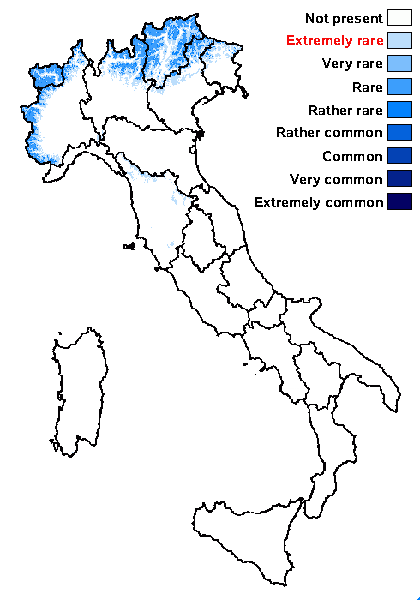
Predictive model
Herbarium samples
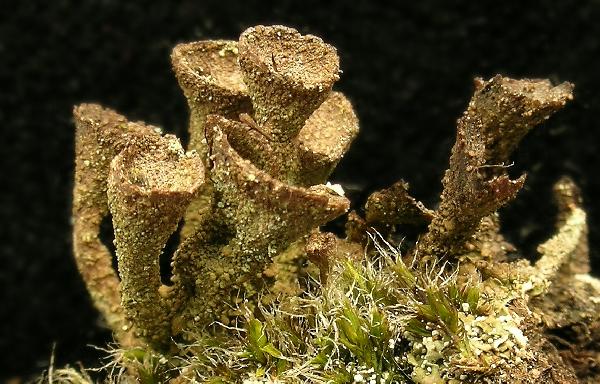
Ulrich Kirschbaum CC BY-SA 4.0 - Source: https://www.thm.de/lse/ulrich-kirschbaum/flechtenbilder
Central Europe; Germany; Hesse: Rhön Mountains.
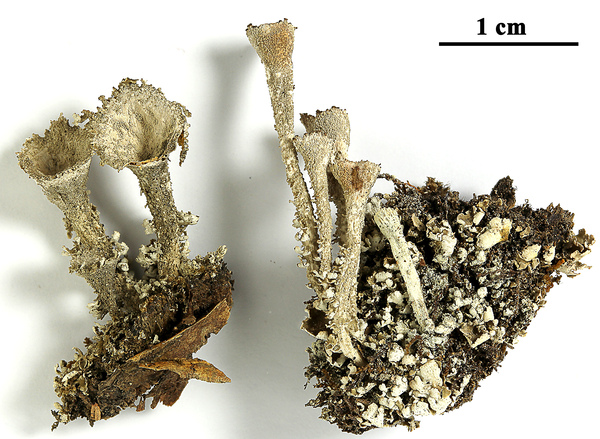

Felix Schumm – CC BY-SA 4.0
[394], Germany, Baden-Württemberg, Schwarzwald, Freudenstadt, TK 7516. Leg. F. Schumm, 4.05.1967.
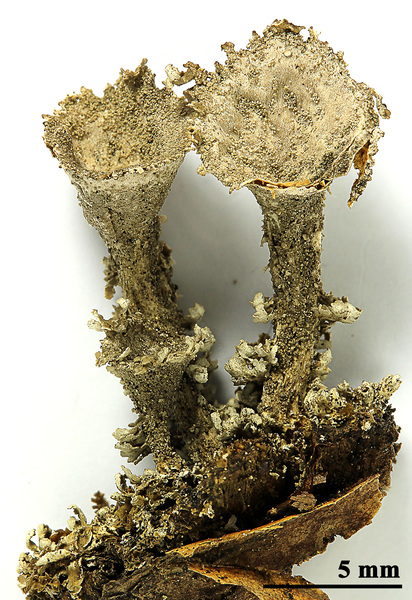

Felix Schumm – CC BY-SA 4.0
[394], Germany, Baden-Württemberg, Schwarzwald, Freudenstadt, TK 7516. Leg. F. Schumm, 4.05.1967.
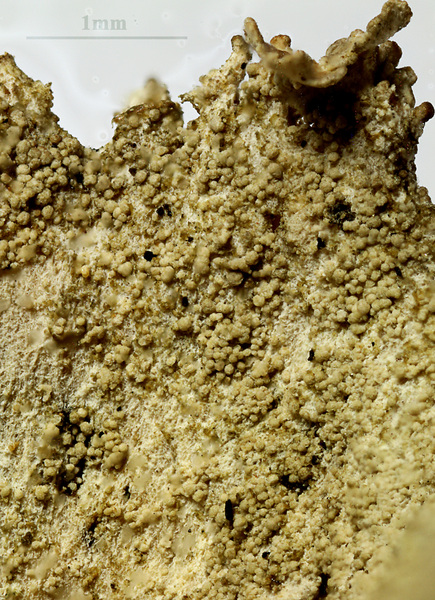

Felix Schumm – CC BY-SA 4.0
[394], Germany, Baden-Württemberg, Schwarzwald, Freudenstadt, TK 7516. Leg. F. Schumm, 4.05.1967.
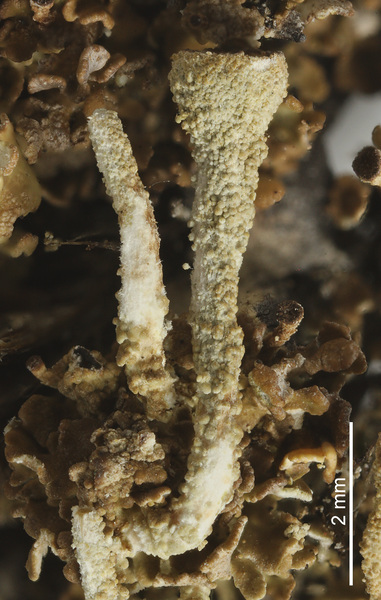

Felix Schumm – CC BY-SA 4.0
[14052], Portugal, Azoren, Terceira, nördlich von Matela an einem Parallesträßchen zur EN3-1; 38°41.461' N, 27°14.999' W, 430 m; an bemoosten, offenstehenden Mauern. Leg. Schumm 18.07.2008, det. Schumm 2013
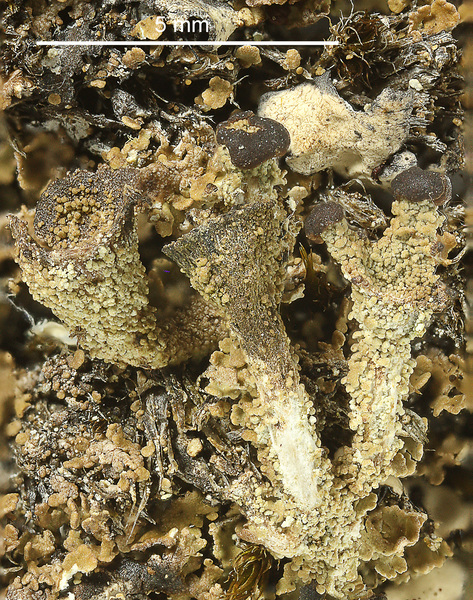

Felix Schumm – CC BY-SA 4.0
[14052], Portugal, Azoren, Terceira, nördlich von Matela an einem Parallesträßchen zur EN3-1; 38°41.461' N, 27°14.999' W, 430 m; an bemoosten, offenstehenden Mauern. Leg. Schumm 18.07.2008, det. Schumm 2013
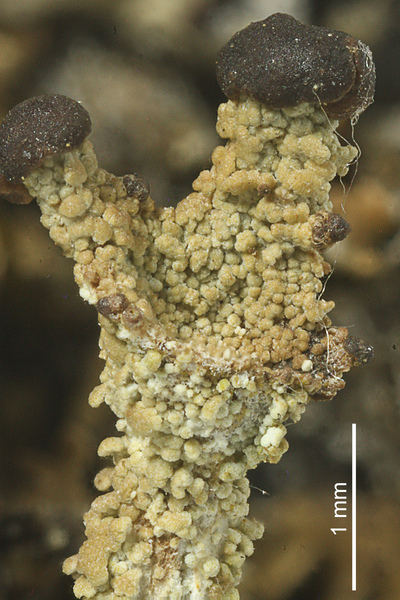

Felix Schumm – CC BY-SA 4.0
[14052], Portugal, Azoren, Terceira, nördlich von Matela an einem Parallesträßchen zur EN3-1; 38°41.461' N, 27°14.999' W, 430 m; an bemoosten, offenstehenden Mauern. Leg. Schumm 18.07.2008, det. Schumm 2013
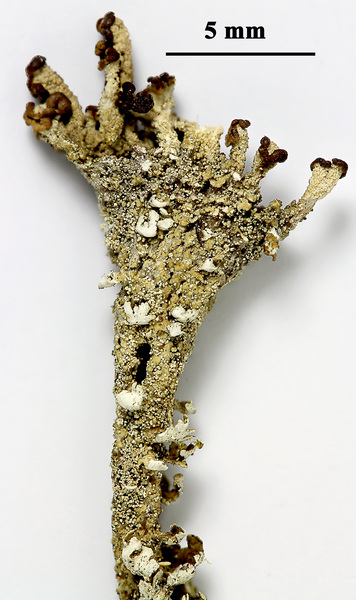

Felix Schumm – CC BY-SA 4.0
[9797], Germany, Baden-Württemberg, Kreis Calw, Wildbad, im kleinen Enztal an der Straße nach Calmbach, TK 7217. Leg. Erich Putzler 15.04.1949, det. F. Schumm.
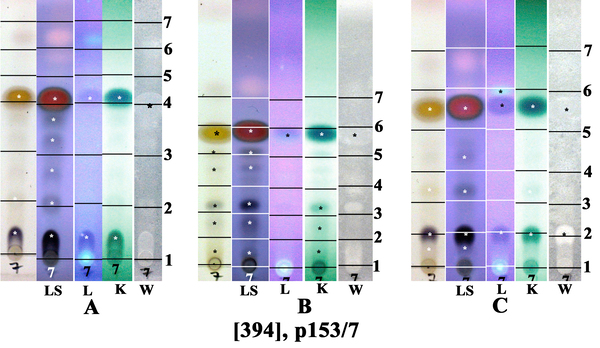

Felix Schumm – CC BY-SA 4.0
[394], Germany, Baden-Württemberg, Schwarzwald, Freudenstadt, TK 7516. Leg. F. Schumm, 4.05.1967.,
4: congrayanic acid ,5: 4-O-demethylgrayanic acid, conf. J.A. Elix

Gabriele Gheza - https://lichenidilombardia.home.blog
Italy, Lombardia, Bergamo, Passo del Vivione, 1830 m
19/08/2016
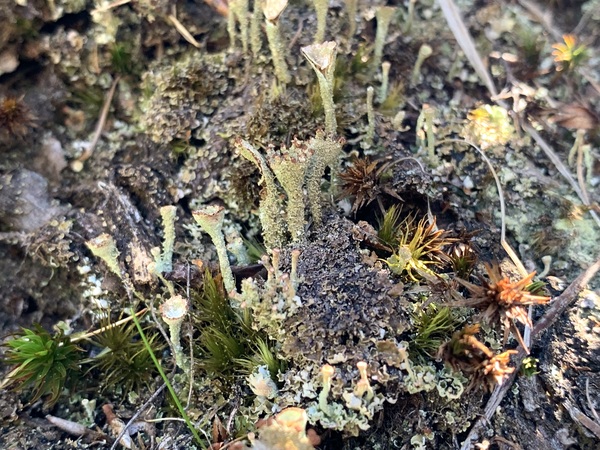
Gabriele Gheza - https://lichenidilombardia.home.blog
Italy, Lombardia, Bergamo, Passo del Vivione, 1830 m
19/08/2016
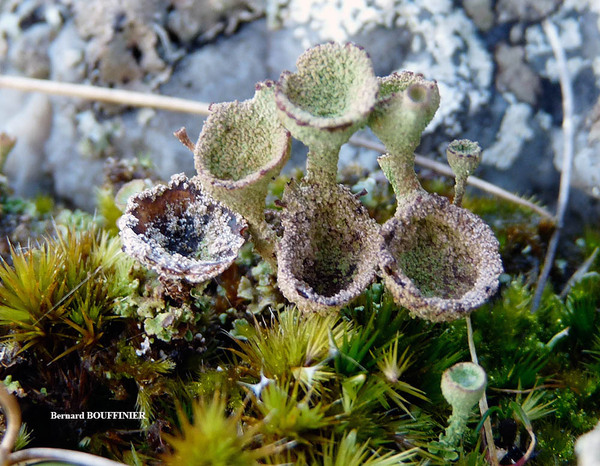
Bernard Bouffinier - Source: http://www.lichensmaritimes.org/index.php?task=fiche&lichen=706&lang=en
France, Guern

Bernard Bouffinier - Source: http://www.lichensmaritimes.org/index.php?task=fiche&lichen=706&lang=en
France, Menez, Hom
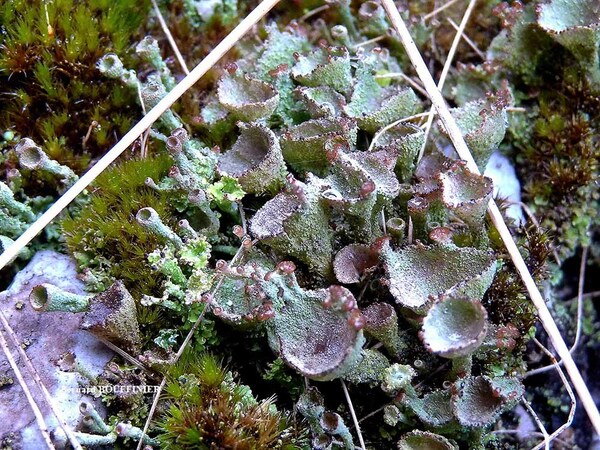
Bernard Bouffinier - Source: http://www.lichensmaritimes.org/index.php?task=fiche&lichen=706&lang=en
France, Menez, Hom
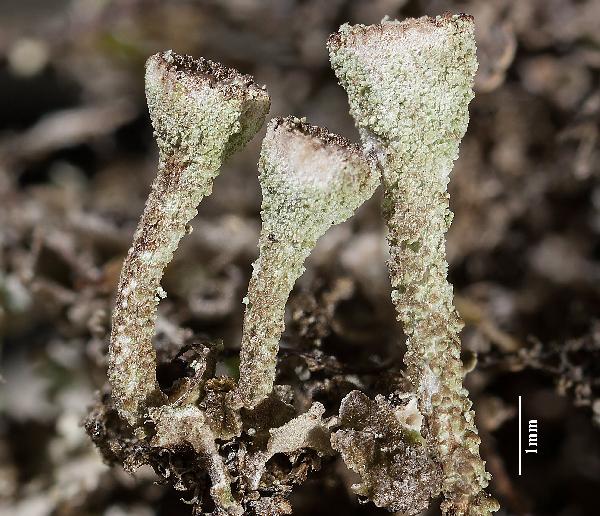
Ulrich Kirschbaum CC BY-SA 4.0 - Source: https://www.thm.de/lse/ulrich-kirschbaum/flechtenbilder
Canary Islands; La Gomera-M: Pajarito.
Growth form: Fruticose
Substrata: lignum, soil, terricolous mosses, and plant debris
Photobiont: green algae other than Trentepohlia
Reproductive strategy: mainly asexual, by soredia, or soredia-like structures (e.g. blastidia)
Commonnes-rarity: (info)
Alpine belt: rare
Subalpine belt: rather rare
Oromediterranean belt: absent
Montane belt: extremely rare
Submediterranean belt: absent
Padanian area: absent
Humid submediterranean belt: absent
Humid mediterranean belt: absent
Dry mediterranean belt: absent

Predictive model
| Herbarium samples |

Ulrich Kirschbaum CC BY-SA 4.0 - Source: https://www.thm.de/lse/ulrich-kirschbaum/flechtenbilder
Central Europe; Germany; Hesse: Rhön Mountains.


Felix Schumm – CC BY-SA 4.0
[394], Germany, Baden-Württemberg, Schwarzwald, Freudenstadt, TK 7516. Leg. F. Schumm, 4.05.1967.


Felix Schumm – CC BY-SA 4.0
[394], Germany, Baden-Württemberg, Schwarzwald, Freudenstadt, TK 7516. Leg. F. Schumm, 4.05.1967.


Felix Schumm – CC BY-SA 4.0
[394], Germany, Baden-Württemberg, Schwarzwald, Freudenstadt, TK 7516. Leg. F. Schumm, 4.05.1967.


Felix Schumm – CC BY-SA 4.0
[14052], Portugal, Azoren, Terceira, nördlich von Matela an einem Parallesträßchen zur EN3-1; 38°41.461' N, 27°14.999' W, 430 m; an bemoosten, offenstehenden Mauern. Leg. Schumm 18.07.2008, det. Schumm 2013


Felix Schumm – CC BY-SA 4.0
[14052], Portugal, Azoren, Terceira, nördlich von Matela an einem Parallesträßchen zur EN3-1; 38°41.461' N, 27°14.999' W, 430 m; an bemoosten, offenstehenden Mauern. Leg. Schumm 18.07.2008, det. Schumm 2013


Felix Schumm – CC BY-SA 4.0
[14052], Portugal, Azoren, Terceira, nördlich von Matela an einem Parallesträßchen zur EN3-1; 38°41.461' N, 27°14.999' W, 430 m; an bemoosten, offenstehenden Mauern. Leg. Schumm 18.07.2008, det. Schumm 2013


Felix Schumm – CC BY-SA 4.0
[9797], Germany, Baden-Württemberg, Kreis Calw, Wildbad, im kleinen Enztal an der Straße nach Calmbach, TK 7217. Leg. Erich Putzler 15.04.1949, det. F. Schumm.


Felix Schumm – CC BY-SA 4.0
[394], Germany, Baden-Württemberg, Schwarzwald, Freudenstadt, TK 7516. Leg. F. Schumm, 4.05.1967.,
4: congrayanic acid ,5: 4-O-demethylgrayanic acid, conf. J.A. Elix

Gabriele Gheza - https://lichenidilombardia.home.blog
Italy, Lombardia, Bergamo, Passo del Vivione, 1830 m
19/08/2016

Gabriele Gheza - https://lichenidilombardia.home.blog
Italy, Lombardia, Bergamo, Passo del Vivione, 1830 m
19/08/2016

Bernard Bouffinier - Source: http://www.lichensmaritimes.org/index.php?task=fiche&lichen=706&lang=en
France, Guern

Bernard Bouffinier - Source: http://www.lichensmaritimes.org/index.php?task=fiche&lichen=706&lang=en
France, Menez, Hom

Bernard Bouffinier - Source: http://www.lichensmaritimes.org/index.php?task=fiche&lichen=706&lang=en
France, Menez, Hom

